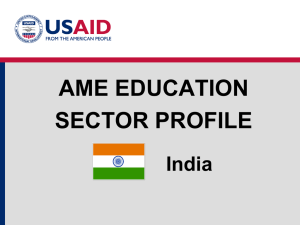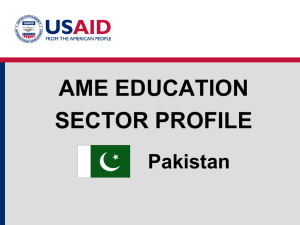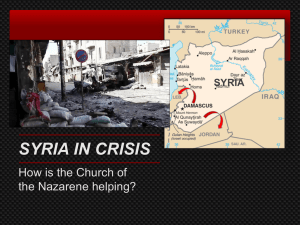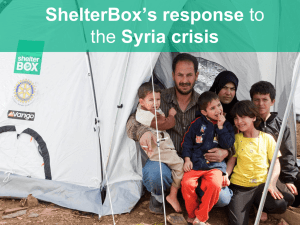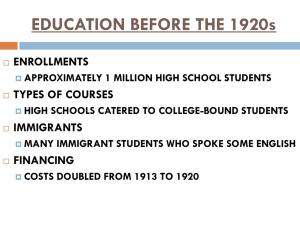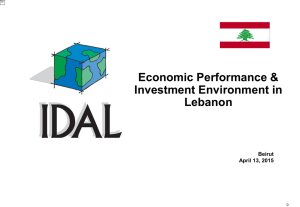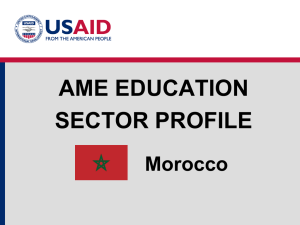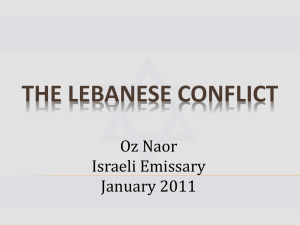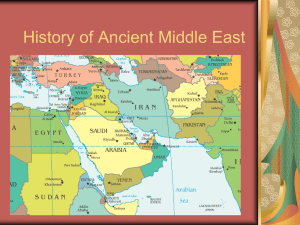Education Sector Profile
advertisement
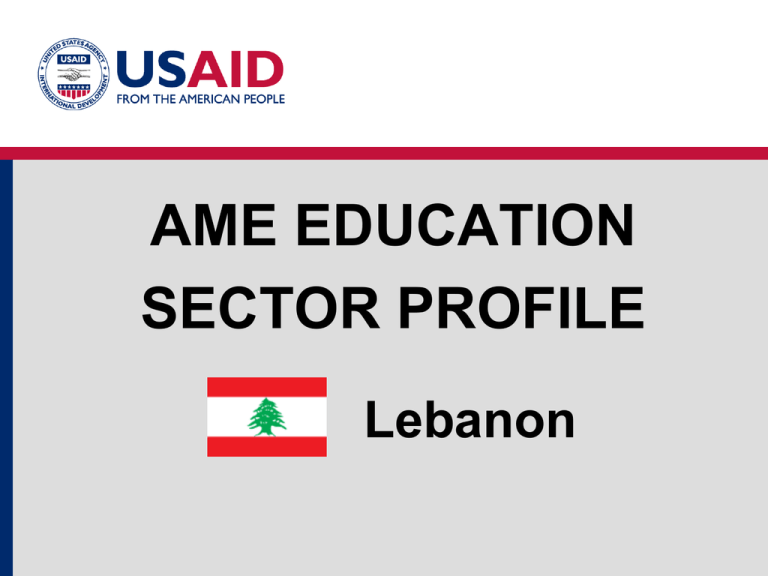
AME EDUCATION SECTOR PROFILE Lebanon Lebanon Education Structure Education System Structure and Enrollments 2007 Source: UNESCO Institute for Statistics. World Bank EdStats Lebanon Education Structure • Compulsory education in Lebanon is from grades 1-9. % Net % Gross Education Configuration and Enrollment Percentages Enrollments Enrollments Classification Pre-primary Level/Grade Pre-school Primary, grades 1-6 Lower Secondary, grades 7-9 Pre-university Upper secondary, grades 10-12 Tertiary Ages 2007 3-5 64% 2007 67% 6-11 83% 95% 12-14 15-17 TVET Secondary 15-17 Undergraduate study Graduate study 17-22 22+ 87% 73% 75% 14% N/A 52%* * Includes all of secondary. ** Includes all categories of post-secondary. Source: UNESCO Institute for Statistics, Lebanon Population Structure • 53% of the population is under the age of 30 but that age group is not projected to grow much larger in the nearer term. • Good educational opportunities for these young people are necessary to support national economic growth. Population Structure: Lebanon 2008 30-65 yrs 39% 65+ yrs 8% 0-14 yrs 27% 15-29 yrs 26% Source: International Labor Organization Lebanon Education Policy Relevant Policies: • Social Action Plan Toward Strengthening Social Safety Nets and Access To Basic Social Services, 2007. http://www.economy.gov.lb/MOET/English/Navigation/News/SocialAction Plan2007.htm • Development Plan for Education in Lebanon, 2008. [in French] http://planipolis.iiep.unesco.org/format_liste1_en.php?Chp2=Lebanon Lebanon Education Access: Pre-university • Secondary enrollments have increased at a marginally greater rate since 1990 at an average of 7.2% than primary education at 5.4%. • Enrollments are quite high indicating the strength of the system to draw children to school. Pre-university Enrollments 90% 1990 80% Enrollments (%) 70% 2008 60% 50% 40% * Preprimary and TVET Secondary are gross enrollments from 2000. 30% 20% 10% 0% Preprimary Primary TVET Secondary Source: UNESCO Institute for Statistics, World Bank EdStats Total Secondary Lebanon Education Access: Tertiary • Despite rising university enrollments (18% since 2000), distribution of students among levels of study has remained remarkably stable. • Higher education produces few graduate degrees, perhaps an indication of difficulties of students to matriculate through the system. 100 University Enrollment and Distribution of Students 90 Enrollments (%) 80 70 GER 60 50 % 4 yr 40 30 % 2-3 yr 20 % graduate 10 0 2000 2002 Source: UNESCO Institute for Statistics 2006 2007 Lebanon Education Access: Gender • Girls are more successful at accessing secondary education with an enrollment rate 7% higher than boys’ rate. • Gender parity (0.97) has nearly been achieved at the primary level with almost equal boys’ and girls’ enrollments. Pre-university Net Enrollments by Gender 95.0% Enrollments (%) 90.0% 85.0% 80.0% 75.0% 70.0% 65.0% 60.0% 55.0% 1997 Primary Boys Source: World Bank EdStats 2000 Primary Girls 2003 2006 Secondary Boys 2008 Secondary Girls Lebanon Education Quality: Teachers • Lebanon has approximately 88,000 teachers in general education. •11-13% of all teachers, grades1-12, are trained but no further information can be found on the process or requirements of professional development. • The average teacher to pupil ratio for grades 1-12 is 11:1 which seems sufficient to cover all classes but may be low in efficiency terms. • Information on teacher recruitment, deployment, qualification standards and training in the public and private sector is limited. Source: UNESCO Institute for Statistics Lebanon Education Quality: Completion • Completion rates declined 13% from 1999-2005 but have since seen a slight rise. • Girls are consistently more successful at completing primary school. Primary Completion Rates by Gender 100 Completion (%) 95 90 85 80 Boys 75 Girls 70 65 60 1999 2001 Source: World Development Indicators (WDI) 2003 2005 2007 2008 Lebanon Education Quality: Testing • Lebanon students achieved the highest mean math score (449) of MENA participant countries on the 2007 test but continue to rank at the low-intermediate level internationally (31 out of 45). • 2007 mean TIMSS scores improved an average of 18 points from 2003 scores. Mean Gr. 8 TIMSS Scores MENA 2007 700 Mean TIMSS Score Advanced Benchmark 600 High Benchmark 500 Intermediate Benchmark Low Benchmark 400 300 200 100 0 Egypt Jordan Lebanon Morocco Science WB/G Math Source: Trends in International Math and Science Study 2007 Singapore USA Lebanon Education Equity: Academic Disparities • Expenditure on pre-university private education amounts to 6% of the GDP. • Approximately 60% of all Lebanese children attend private school. Pre-university Public/Private Enrollments 2006-07 120.0% Enrollments (%) 100.0% 80.0% 45.4% 61.8% 57.6% 60.0% 46.9% 50.9% 0.0% 22.2% 40.0% 0.0% 16.0% 20.0% 22.1% 32.4% 42.4% 13.5% 53.1% 35.6% 0.0% Preprimary Primary Public Source: Lebanon Ministry of Education Junior Secondary Secondary Semi-Private Private Total Lebanon Education Efficiency: Expenditure • Lebanon is the lowest spender on education in the region but together with the large expenditures of the private sector, education is well-supported in the country. Public Spending on Education in MENA Share of GDP OECD Share of Publc Spending 5 1 18 MENA 5.2 17.5 West Bank/Gaza 6.2 11.5 Morocco 28 2.3 Lebanon 12.5 6.8 Yemen 21.2 6.5 Jordan 13.5 6 Egypt 18 Source: World Bank EdStats, World Bank 2008, Yemen Ministry of Higher Education Lebanon Education Efficiency: Expenditure • As a result of focused spending on pre-university levels , enrollments have consistently increased. Now the government needs to focus on improving quality of education in the classroom. Education Spending Pattern 2005 30% 25% 36% 9% Primary Source: World Bank EdStats Secondary Tertiary Other Lebanon Education Efficiency: Repetition • Repetition rates at both levels are quite high and have not declined significantly over the years. Pre-university Repetition Rates 13 Repetition Rate (%) 12 11 10 9 8 7 Primary 6 Secondary 5 4 1990 2000 Source: World Development Indicators (WDI) 2002 2004 2007 Lebanon Education Efficiency: Repetition • Using repetition as an indicator of quality, private schools provide a better education than public schools do. • Private schools have minimal percentages of two or more year repeaters while public schools have 4-11% more across all levels. Percentage Repeaters by Type of School 45.0% 19.2% Repeaters (%) 40.0% 14.0% Repeated Two or More Years, % of Total Enrollment 19.8% Repeated One Yr, % of Total Enrollment 35.0% 30.0% 10.3% 25.0% 15.1% 11.4% 20.0% 15.0% 7.2% 3.1% 10.0% 5.0% 4.2% 12.3% 10.9% 6.0% 6.2% Public Private 19.5% 13.1% 8.6% 2.6% 6.8% 0.0% Total Primary Source: Lebanon Ministry of Education Public Private Total Lower Secondary Public Private Secondary Total Lebanon Education Efficiency: Repetition • Lebanon is the poorest performing country in the region as far as public expenditure on education and addressing the repetition issue. Public Spending on Education and Primary Repetition Rates MENA (most recent years 2001-2007) 14 % GDP 12 Repetition Percentage 10 8 6 4 2 0 Morocco Jordan Source: World Bank EdStats Egypt Lebanon Yemen MENA OECD Lebanon Education: Conclusion Successes: • Access: High primary and rising secondary enrollments. Approaching gender parity at primary. On track to attain UPE. • Quality: Improving scores on the TIMSS. Highest math score regionally. • Equity: • Efficiency: Equitable division of budget across education levels. Challenges: • Access: Lower access rates for males from secondary level on up. • Quality: High and intractable repetition rates. Poorly qualified teachers. • Equity: Parallel education system offered by the private sector which favors wealthier students. • Efficiency: Inadequate education expenditures to address repetition rates.
